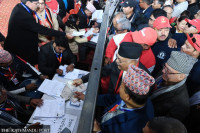National
Was she inappropriate or a victim of misogyny?
While some saw Sumana Shrestha’s dress as unseemly for MP, others thought she was unfairly targeted as a woman.
Anup Ojha
On May 8, Sumana Shrestha, a member of parliament from the Rastriya Swatantra Party (RSP), raised a series of questions about the wrong template of budget, its systematic failure in the three layers of administration and criticised the government for failing to introduce a much-needed ‘social security programme' to help people cope with the economic crisis.
Shrestha appeared bold, clear and confident when she put across her ideas before fellow parliamentarians.
But the attire she was wearing—a pair of pants, black vest and a coat—dragged her into controversy.
Although she was praised for her fearless speech, many raised questions about the clothes she wore to Parliament, saying it violated the dress code.
Later, on May 14, the Business Advisory Committee of the Parliament discussed the issue and decided to make it mandatory for lawmakers to wear a coat or a half coat. Also, they can wear cultural attire reflecting the community they belong to, if they wish, the committee decided.
Ekram Giri, spokesman for the House of Representatives, said the committee discussed the matter last week. Section 242 (1) of the House of the Representations Regulations-2023 states that the dress code for members of the House shall be as determined by the Speaker in consultation with the Business Advisory Committee.
“While determining the dress code in accordance with the sub-section (1), the aspects of decent attire or dress reflecting formal, original culture and tradition or identity should also be kept in mind,” states section 242 (2) of the regulations.
Giri, however, claimed that the committee’s decision was independent of the Shrestha attire controversy. The issue was already under discussion at the committee, he said.
However, many have criticised the decision claiming it was targeted at Shrestha as she has been vocal on the fake Bhutanese refugees’ scam and other corruption issues.
Until Sunday, the police had apprehended 13 people in connection with the scam, including high-profile politicians like UML leader and former deputy prime minister Top Bahadur Rayamajhi and Congress leader and former home minister Bal Krishna Khand.
When the Post contacted RSP lawmaker Shrestha, she said her dress issue has been unnecessarily raked up to divert attention from the big corruption matters.
“For months since its election last November, the House of Representatives has not passed a single bill, and we have such a big issue of corruption,” said Shrestha.
She said the code should be clear what kind of dress is not allowed in the House. “Just making a dress code mandatory does not make sense, it has to be implemented strictly and everyone must be checked for dress before entering the House,” said Shrestha.
She, too, questioned the misogynistic views of society. “When Gagan Thapa [a lawmaker] comes to the House in a pair of jeans, T-shirt and coat, nobody makes an issue of his getup,” said Shrestha.
Recently, after the dress controversy, Shrestha presented her own view on the issue, with one of her tweets on May 15 reading, “What are the priorities of the government? Should we be acting as moral police or focussing on House committee meetings? Why is this distraction strategy being employed when we are looking into a major corruption scandal?”
The dress issue has divided public opinion on social media.
Twitter user Indira (@Lawyerindira) wrote: “This is too much from you. There is no doubt you have presented yourself emphatically, but I don’t agree with your view that dress code is unnecessary. This is Nepal, we have our own original attires, does it lessen our expertise when we wear them?”
Renowned actor Manisha Koirala also joined the debate. She is of the view that members of parliament should wear decent formal dress when they take part in House business. “One is free to wear what ever in ones home..parliament is not such place!I totally disagree!!she speaks well agreed n I have applauded her but there is a decorum to follow..jeans and a tank top in parliament?Seriously that’s how casual you are n next is flip flop with beachwear?” she wrote on Twitter.
Meanwhile, another tweet by Bishan Kshetri @Itsbishan read: “There are some rules in society, and society progresses by following them. Otherwise, there would be no distinction between humans and animals. Instead of dismissing the code as a strategic attack, it is better to abide by the code and abandon the righteousness.”
In 2021, the speaker of the British parliament issued a warning note to the British members of parliament that read: “Jeans, chinos, sportswear or any other casual trousers are not appropriate. T-shirts and sleeveless tops are not business attire. Smart/business shoes are expected to be worn. Casual shoes and trainers are not appropriate. Men are encouraged to wear a tie, and jackets must be worn.”
Meanwhile, in neighbouring India, there is still an ongoing debate on what the lawmakers should wear to parliament.
Former general secretary of Parliament Secretariat Surya Kiran Gurung says Nepal’s lawmakers started breaching the dress code after 2006. He said until then there was no problem in maintaining the dress code in the House. “When CPN-Maoist joined the reinstated parliament in 2006, the House saw some deviations in the dress as the former rebels started wearing attires in their own style,” he said. “In the initial days, all the Maoist lawmakers used to attend House meetings in grey coats and pants.”
Gurung thinks there is a need to make and follow dress code in Parliament. “Because it maintains the decency of the House,” he said.
Shrestha’s way of presenting herself in the House did find some supporters though.
Suman (@SGnepal) posted a tweet on Tuesday with two different photos of Shrestha and Nepali Congress General Secretary Gagan Thapa. The text read: “The same Parliament and similar T-shirts: When a woman wears it, it becomes objectionable, but nobody cares when a man wears it. Isn’t that funny?”
Meanwhile, a few others compared Shrestha’s dress sense with Kathmandu mayor Balendra Shah’s ‘cool’ getup involving dark glasses, T-shirt and jeans. “I think a lot about what guides our thinking. While we proudly share The New York Times article that says Mayor Balen walks into office with dark glasses and jeans. On the other hand, we tell Sumana Shrestha to refrain from wearing jeans to Parliament. Could it be misogyny or some other sociological reasons?” wrote Yatish who goes with the Twitter handle @yatisshh.
Senior advocate Meera Dhungana said the issue of dress code should not be taken so seriously.
“In Shrestha’s case, she might not have been aware of it. She should not be humiliated for that,” said Dhungana.
Former chief justice of the Supreme Court Sushila Karki is of the view that the dress code should be made mandatory only if the majority of lawmakers approves of it.
“But what I personally think is that if one is good at heart and speaks the truth, a dress code is not necessary,” said Karki. She said what one does in the House is more important than what one wears. “In public forums, everyone should wear decent clothes, there should be no vulgarity, but wearing a comfortable dress is okay.”
Some observers say it would be more appropriate to make a dress code mandatory for special occasions.
Anthropologist Suresh Dhakal says Shrestha’s dress code was raised also because she has presented herself as a vocal woman lawmaker in the House.
“There are many women parliamentarians, but as they are not as vocal, they don’t get noticed,” said Dhakal.




 19.12°C Kathmandu
19.12°C Kathmandu.jpg)















